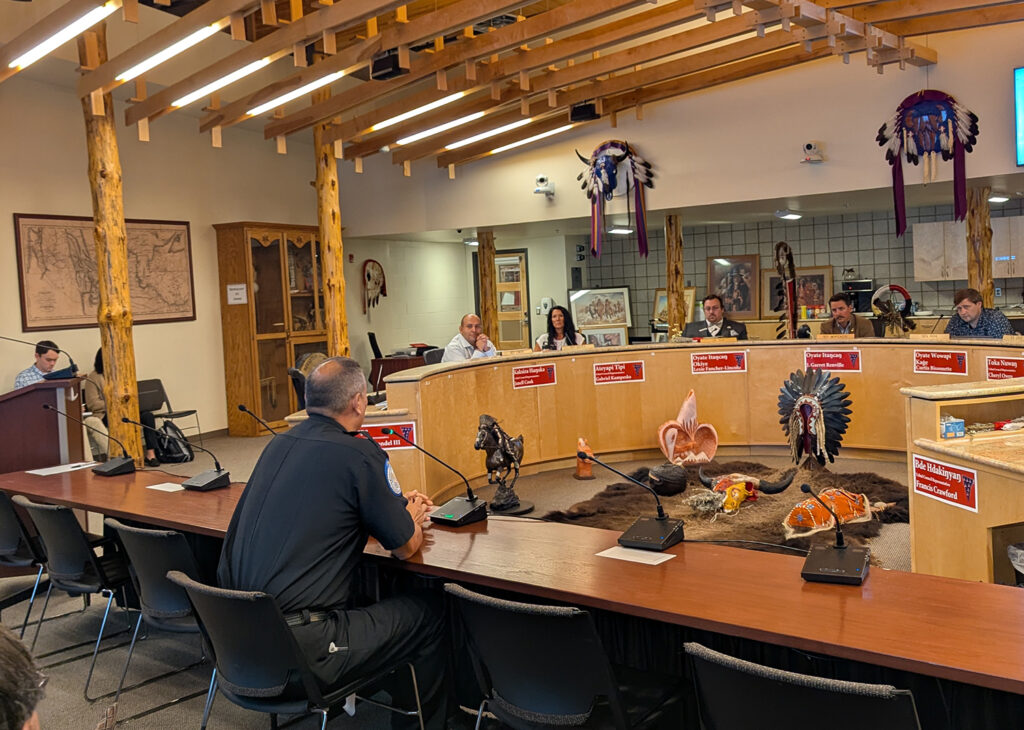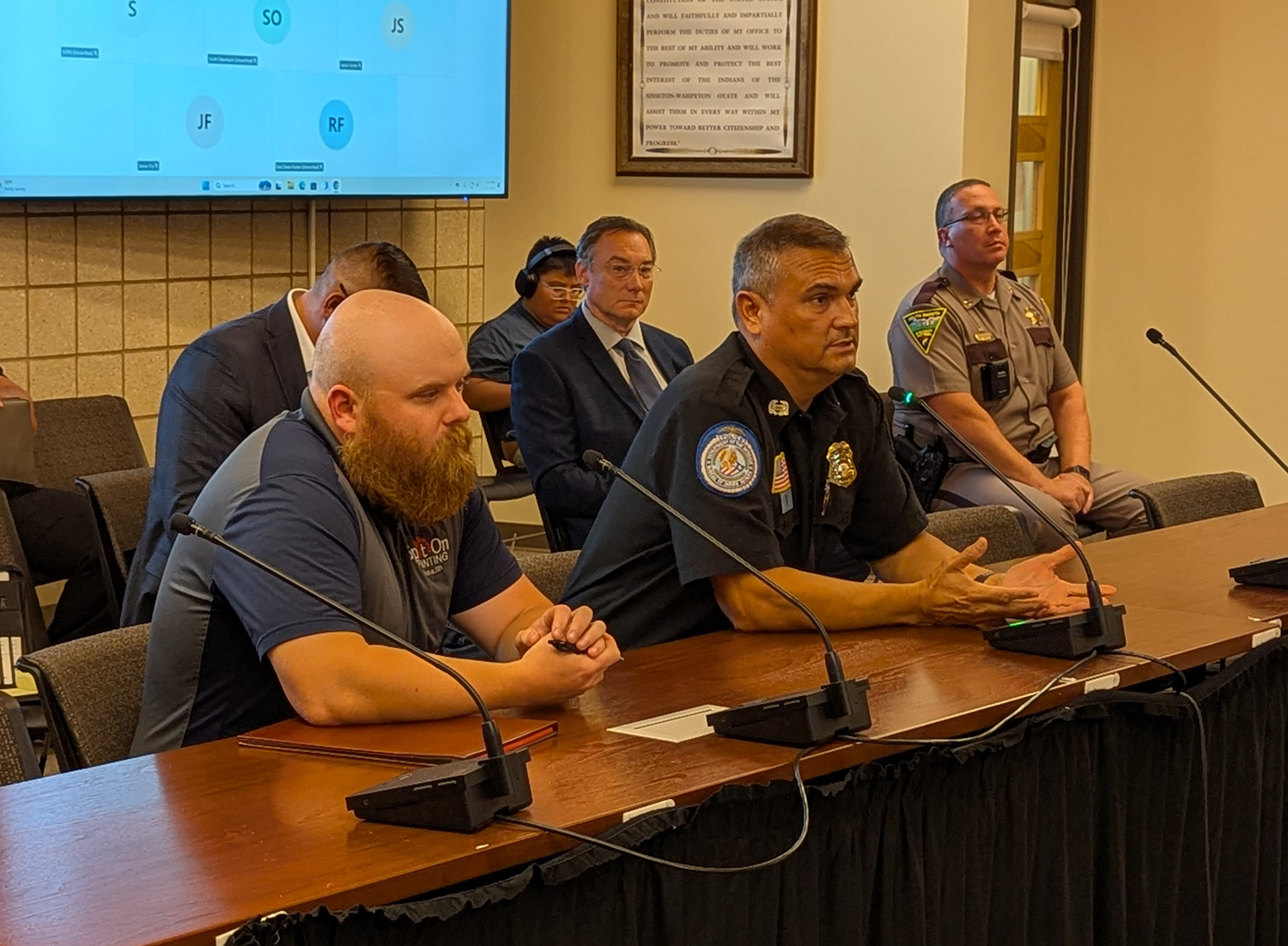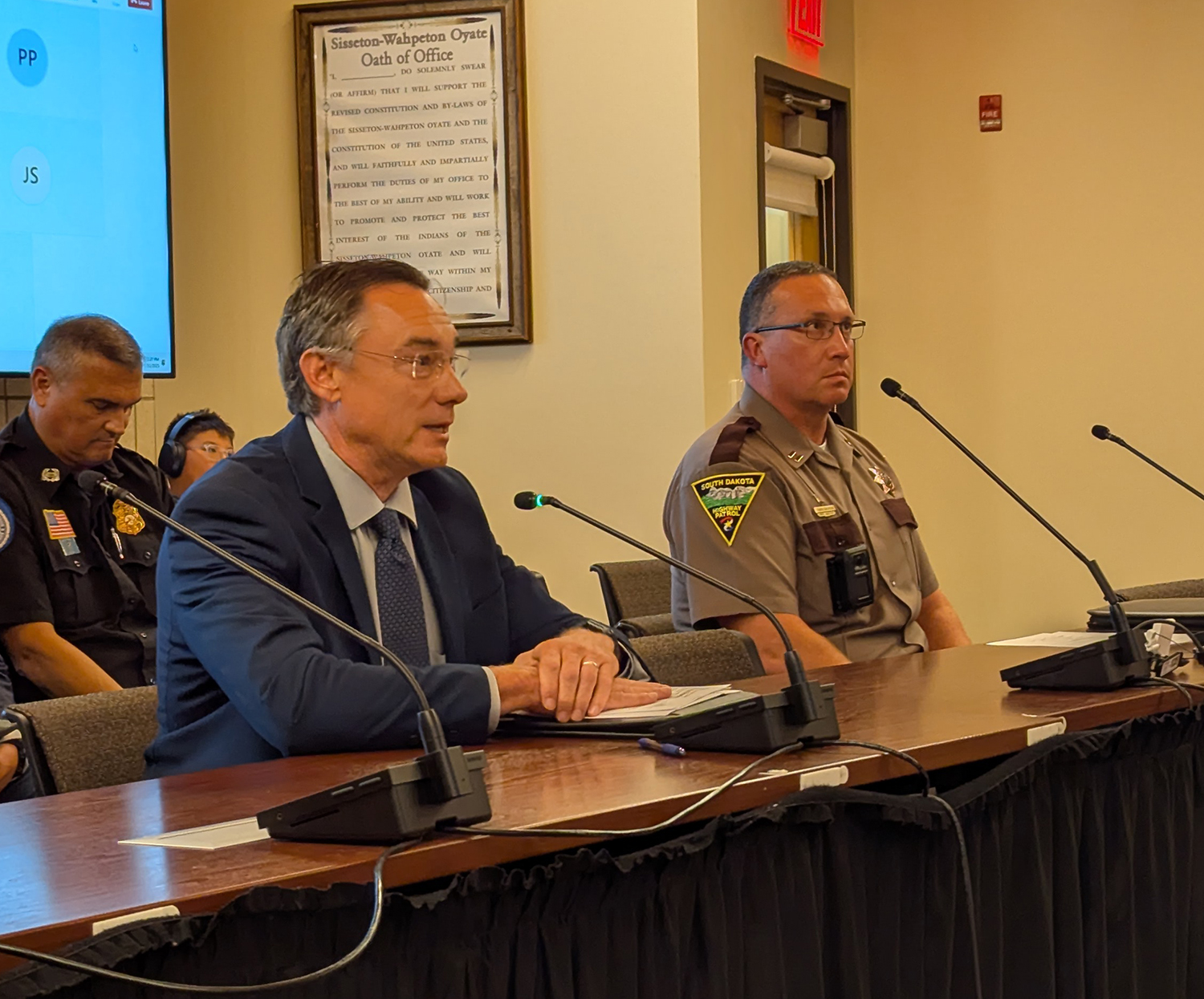
Sisseton-Wahpeton Police Captain Gary Gaikowski speaks to the State-Tribal Relations Committee on July 31, 2025, in Agency Village. (John Hult/South Dakota Searchlight)
AGENCY VILLAGE — If a Sisseton police officer gets punched on state land in Sisseton, Roberts County State’s Attorney Dylan Kirchmeier can charge the assailant with a felony for assaulting a police officer.
If that assailant also punches a tribal police officer who’s there to assist, Kirchmeier doesn’t have that option.
South Dakota law doesn’t include tribal police in its definition of a law enforcement officer, Kirchmeier told members of the State-Tribal Relations Committee on Thursday. But in Roberts County, tribal police work alongside sheriff’s deputies and city officers on a regular basis, sometimes as backup, sometimes as first responders when they’re closer to the scene when a call comes in.
“I feel like that is doing a disservice to the tribal officers, because they’re doing the same job that any state law enforcement officer is,” Kirchmeier said. “It’s a bad loophole.”

Roberts County State’s Attorney Dylan Kirchmeier, left, and Sisseton-Wahpeton Police Captain Gary Gaikowski speak to the State-Tribal Relations Committee on July 31, 2025, in Agency Village. (John Hult/South Dakota Searchlight)
Roberts County includes parts of the Lake Traverse Reservation, where the Sisseton-Wahpeton Police Department and tribal courts have jurisdiction. But the checkerboard nature of tribal land – one side of the road can be tribal, the other state – means that policing agencies wind up interwoven, for the safety of their officers and residents alike.
It’s not uncommon for suspects to cross tribal and state lines in the course of committing a crime, Kirchmeier said, particularly in vehicle pursuits.
Gary Gaikowski, the tribal police captain for the past 20 years and a longtime member of South Dakota’s Law Enforcement Standards and Training Commission, said the working relationships benefit both sides and public safety.
“Everything that affects the state, Roberts County, the city of Sisseton, affects us,” Gaikowski told the committee. “And most of the time, it’s the same individuals that we’re arresting.”
That should move the Legislature to change the law to recognize tribal officers as law enforcement.
“It does kind of, excuse my language, suck, to not be recognized as law enforcement officers,” he said.
Both men urged the committee to explore changes to the law to protect tribal police who aid their stateside counterparts.
Mutual aid agreements: Thorny territory
Gaikowski said he understands the thorny nature of cooperation between tribes and outside law enforcement. Attempts to push for more formal mutual aid agreements have met political resistance at the tribal council level, he told the committee.
Algin Young, South Dakota’s secretary of tribal affairs, told the committee he faced some of the same resistance during his stint as chief of the Oglala Sioux Tribal Police Department in Pine Ridge.
Tribal governments don’t want state officials arresting their citizens, Young said, but might nonetheless see value in outside help. Working with the tribe and Pennington County eventually led to a setup in 2022 that opened the door to mutual aid between the county and the tribe, Young said, without giving the county the power to enforce state law on tribal land.
That should be the model for a state agency like the Highway Patrol, Young said.

“We have to be sensitive to what the tribes want,” he said. “We’ll go when they want, and we’ll leave when they ask us to.”
Bob Perry, secretary of the Department of Public Safety, told the lawmakers on the State-Tribal Relations Committee that the state is working with tribes to convince them to allow more agreements like that. He recently traveled to the Yankton Sioux Tribe to meet with leadership on the possibility of agreements with the Highway Patrol.
The state’s closest formal partnership is with the Crow Creek Sioux Tribe, which uses state troopers for law enforcement only during its annual powwow, but Perry said there are other signs of progress on public safety cooperation.
There’s currently a Highway Patrol saturation operation taking place on the Standing Rock Reservation. Highway Patrol captains meet quarterly with officials on that reservation, and on the Cheyenne River Reservation.
“All law enforcement understands this is a good, good thing,” Perry said of mutual aid. “But there’s still some mistrust in the tribal communities that we have to overcome.”
Possible model: Missing people and violent crime
Perry pointed out that the Highway Patrol does accident reconstruction in fatal crashes on tribal land, and it doesn’t hesitate to put helicopters in the air if a child goes missing on tribal lands and tribal officials reach out for help.
Mark Van Norman, a special counsel for the Sisseton-Wahpeton Oyate, told the committee that the prevalence of missing and murdered Indigenous people and the widespread hunger to address the issue among tribal governments could serve as a building block for trust.
President Donald Trump signed an executive order to address the MMIP issue, Van Norman pointed out, so there’s a willingness at the federal level to improve cooperation.
“We’ve been thinking that when we have missing people, that we would like to get an immediate response so that we can try and rescue the people within 72 hours,” Van Norman said.

Agreements for mutual aid in missing people cases could naturally extend, Van Norman said, to cooperation on cases involving violent crime.
Concerns about jurisdictional challenges aren’t especially pronounced for Gaikowski, Kirchmeier and Roberts County Sheriff Tyler Appel, the sheriff said. Appel’s jail holds adult and juvenile inmates for the tribe, he said, and major cases like homicides are all-hands-on-deck situations.
“Perceptions from community members tend to be more of a challenge than us working together,” Appel said. “Captain Gaikowski’s department and I work very well together. Gary and I share phone calls and text messages on a pretty frequent basis.”
Pierre Republican Rep. Will Mortenson, the committee’s chair, said he was encouraged to hear that, and said he hopes the state can make more progress in allowing police to help each other across tribal lines.
“It seems like what we need is for the politicians to have the trust in law enforcement that law enforcement has in each other,” said Mortenson, a member of the Cheyenne River Sioux Tribe. “The more I think about this issue, the more I think we’ve got a politician problem, not a law enforcement problem.”
After the meeting, Mortenson said his comments were a reference to politicians “on any side” who might monkeywrench mutual aid.
The committee’s next meeting will take place in mid-September, he said, and will be hosted jointly by the Cheyenne River Sioux Tribe and the Standing Rock Sioux Tribe.
GET THE MORNING HEADLINES.


